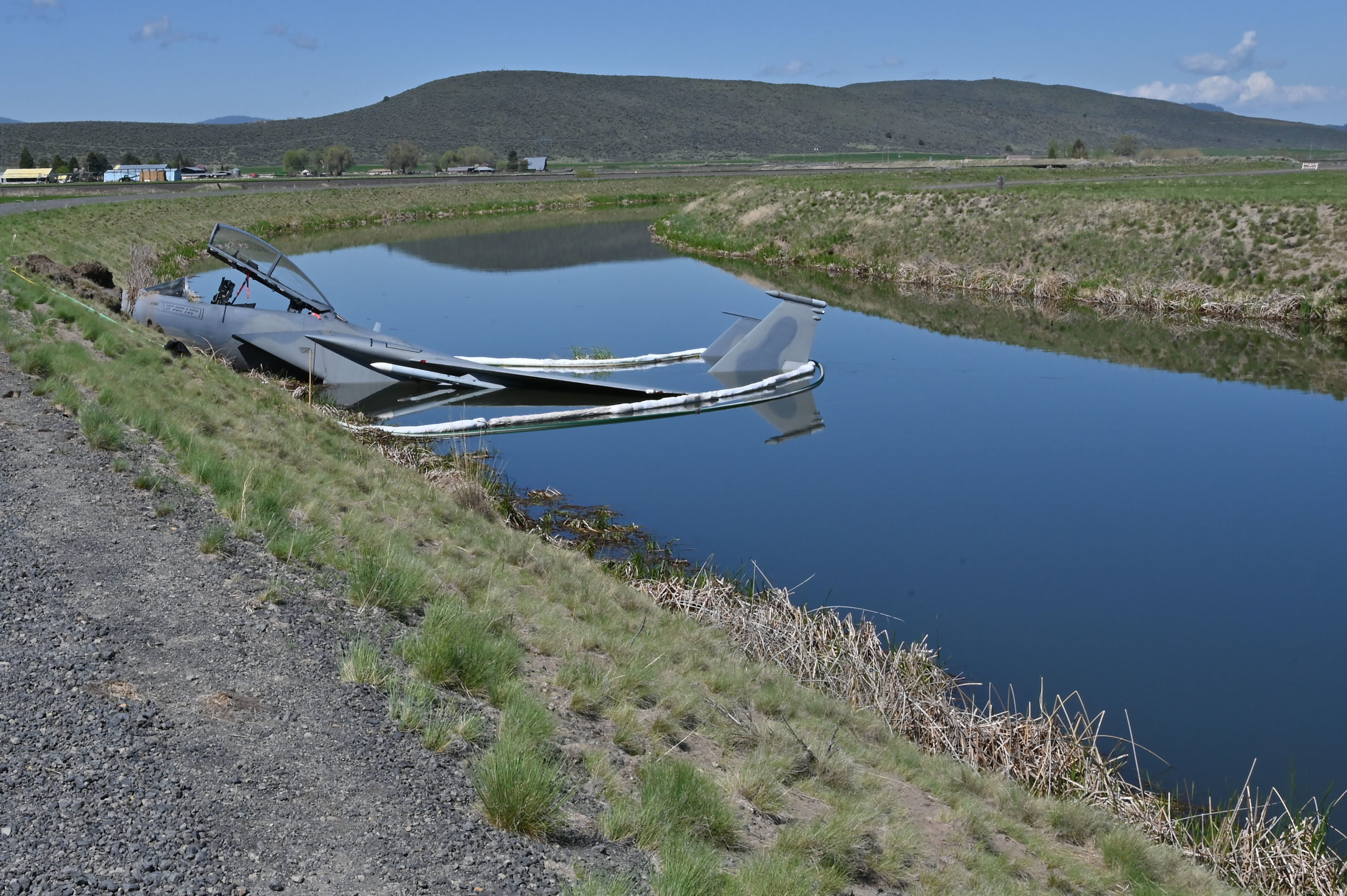A series of errors by the pilot, air traffic controller, and maintainers all contributed to launch an F-15D careening off the runway and into an irrigation canal at Kingsley Field, Ore., last year, investigators said. The accident destroyed the $35 million fighter.
An Air Force Accident Investigation Board report, released June 4, faulted the pilot for choosing the wrong action, the controller for poor communication, and the maintenance crew for insufficient care. These were the central and contributing causes of the May 15, 2023, accident, which ended with the twin-seat fighter lying mostly underwater. The pilot emerged from the crash with non-life-threatening injuries.
According to the report, a single aviator was operating the aircraft as part of a four-ship formation from the Oregon Air National Guard’s 173rd Fighter Wing. The Eagles were training with nearby F-35s and were returning to Kingsley Field on a low-level route, when the pilot was alerted to a hydraulic malfunction. Told by the pilot’s wingman that “hydraulic fluid was leaking from behind the right main landing gear and now trailing the [aircraft] between the exhaust nozzles,” the pilot declared an in-flight emergency, abandoned the route and headed back to Kingsley.
On approach, the pilot alerted the tower and said he would try to land normally, but go around if the brakes failed, before trying to land a second time using the F-15’s emergency tailhook. The air traffic controller responded that the runway’s arresting cable, which catches the tailhook, was up.
The pilot touched down and tried to brake. About halfway down the 10,000-foot runway, he decided he lacked the time and space to safely execute a go-around, so decided instead to deploy the tailhook, radioing the tower the single word “cable.”
“The [air traffic controller] understood the radio transmission to mean the [pilot] wanted the cable down, activated the switch to lower the arrestment cable and approximately three seconds later transmitted ‘cable coming down’ on tower frequency,” the report states. “Approximately seven seconds later … the [pilot] transmitted ‘no, no, I need cable, cable up, cable up, cable up, cable up.’ Approximately four seconds later, [the air traffic controller] activated the switch to raise the cable and responded, ‘cable up.’”
It was too late.
The F-15’s tailhook missed the arresting cable, and the pilot decided not to engage the fighter’s emergency brake system. He subsequently told investigators that he did not want to use the emergency system because technical orders caution against doing so when the aircraft is going above 70 knots calibrated airspeed and recommend applying light pressure at first.
“During the AIB interview the [pilot] described being involved in previous F-15C loss of brakes incidents where use of the Emergency Brake/Steering system resulted in blown tires,” the report states. The pilot indicated concern about losing directional control of the plane.
But without the emergency brake, the pilot lost control. When he steered around a lighting system, the report states, the jet “struck a raised retention berm on the northside, momentarily became airborne, and impacted the southside berm of the irrigation canal.”
Using interviews, simulators, flight data, and technical documents, investigators subsequently concluded the most direct cause of the mishap was the failure to use the emergency brake system, a decision that went against the emergency checklist.
“Engaging the Emergency Brake/Steering system may or may not have resulted in blown tires or damage to the landing gear but would have ultimately prevented the mishap,” the board president wrote. A simulation employing the same circumstances showed the aircraft could have safely stopped before leaving the runway.
Other factors contributed, however:
- The air traffic controller should have recognized when the pilot deployed his emergency tailhook
- The pilot’s one-word communication with the air traffic controller did not follow Air Force procedure, creating confusion, and
- The controller did not confirm with the pilot before lowering the arresting cable.
“It is also likely that the departure-end arrestment cable would have remained in the raised position had the [pilot] said nothing, as [the air traffic controller] had already communicated that the cable was raised prior to the … landing,” the board president noted.
Beyond that, investigators determined that maintainers failed to do their job in preventing the hydraulic failure that caused the in-flight emergency.
On May 3, 12 days before the mishap, the aircraft suffered a utility pump failure that caused a flight to be aborted on the ground and led to an overhaul of the utility hydraulic system. The aircraft didn’t fly again until a prior flight the same day as the mishap.
“After the first flight, maintenance personnel reported a possible Utility System hydraulic leak during the Thru-Flight inspection,” the report noted. They found hydraulic fluid leaking under a door just behind the main landing gear and conducted a quick fix before clearing the aircraft to fly again, without properly documenting their actions.
“These factors should have indicated to maintenance personnel that a more thorough evaluation was required, and had proper maintenance procedures been followed to isolate the leak, there is a high likelihood that the MA would have been deemed Non-Mission Capable (NMC) on the day of the mishap,” the board president wrote. Subsequent analysis determined the cause of the leak was a crack near a weld on the Fuel Oil Heat Exchanger.
The loss of the F-15 shrinks an already small fleet of two-seat D models. As of September 2023, there were just 12 F-15Ds across the entire Air Force and Air National Guard. The planes average more than 36 years of age. The Air Force plans to retire most of its C and D models in the coming years and last year announced, just days after the mishap, that it plans to put an F-35 Formal Training Unit at Kingsley.
